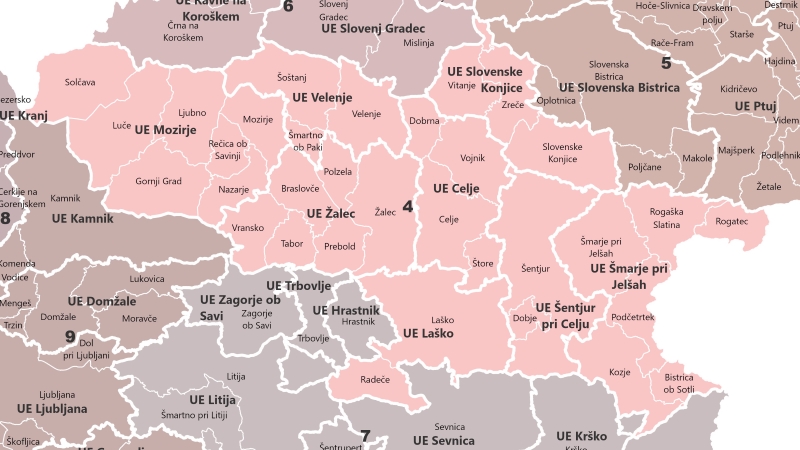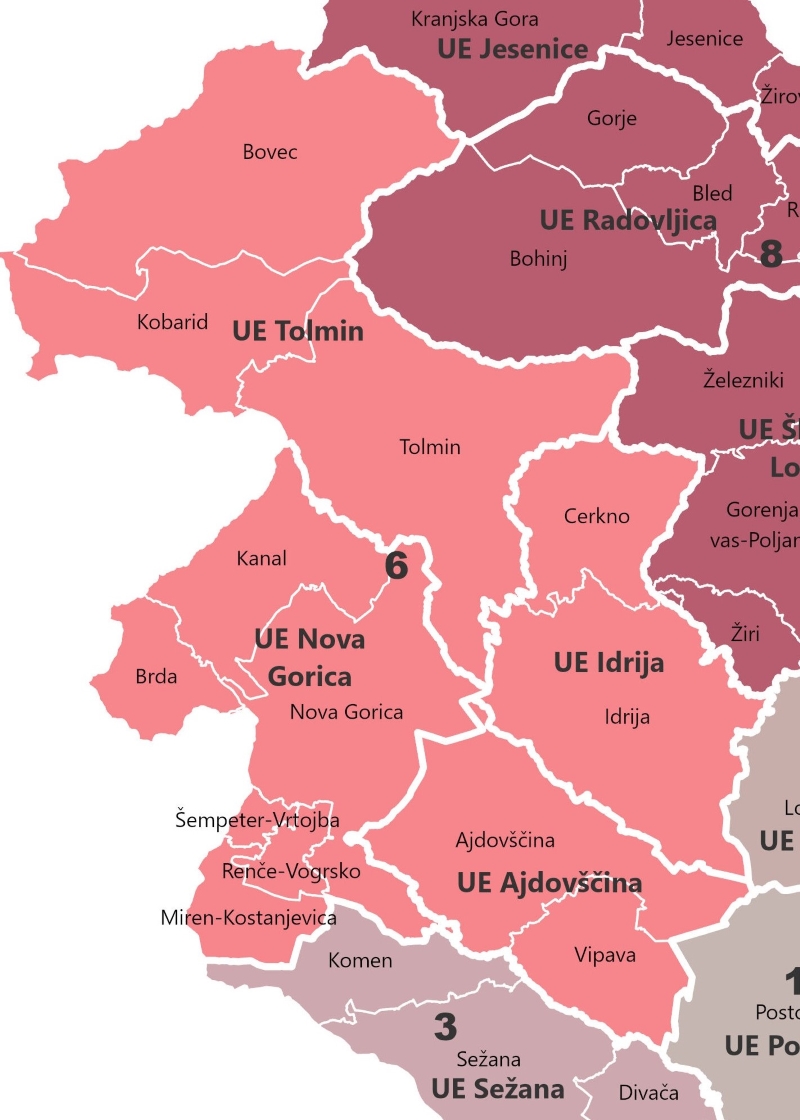The Ministry of Natural Resources and Spatial Planning is launching a gradual introduction of the eConstruction system. The system will ensure electronic commerce in the field of construction. It is set up as a building block of the Spatial Information System.
ELECTRONIC COMMERCE IN THE FIELD OF CONSTRUCTION
eConstruction enables electronic commerce in the field of construction (of buildings). eConstruction actively involves investors, designers, developers, administrative and inspection authorities, municipalities, the Ministry of Natural Resources and Spatial Planning and the public.
The data on buildings and construction collected in the system are stored in a Construction database, which is open for the public, potential investors, designers, administrators, inspectors and other users.
What does eConstruction enables?
eConstruction enables:
- direct data entry from linked official registers and databases,
- assistance in the preparation of project documentation with many automations and tools,
- submission of official applications for project conditions and opinions,
- submission of applications in administrative procedures for the construction of buildings,
- registration of preparatory works and start of construction,
- payment of taxes and fees,
- procession of applications and reception of requests and decisions from administrative authorities and official stakeholders in the procedure,
- access to the status of application
- public access to the documentation of integral procedures, with the possibility of notifying participation in the procedure.

What will be the key advantages of the system once it is fully established?
Key benefits of the system for decision-makers:
- electronic ways of doing business,
- standardisation of procedures and services,
- improving data quality,
- better control of the implementation of procedures.
Key benefits of the system for citizens:
- electronic ways of doing business,
- better information about how the procedures is carried out and implemented.
- improved access to data (information?)
- faster processing of applications.
How the eConstruction is going to be implemented?
The implementation of eConstruction consist of:
- setting up a system for registering administrative acts in the field of construction. The system is already operational in all administrative units, the Ministry of Natural Resources and Spatial Planning and the Inspectorate of Natural Resources and Spatial Planning. The system registers all administrative acts in the field of construction (building permits, use permits, inspection decisions). Basic data on building permits, use permits, notifications to start construction, etc. are already publicly available through the Construction (Building) Database.
- the gradual introduction of a system that will establish electronic commerce in the field of construction (of buidings).
When will eConstruction be set-up?
In accordance with the Building Act (Art. 137), eConstruction will be established within the Spatial Information System by 5 January 2026. The system will be gradually introduced in the areas of all administrative units and the Ministry of Natural Resources and Spatial Planning.
Phasing-in of the system:
- Phase 1 - 7 March 2024: Postojna Administrative Unit;
- Phase 2 - 9 May 2024: Cerknica and Ilirska Bistrica administrative units;
- Phase 3 - 26 September 2024: Izola, Koper, Piran and Sežana administrative units;
- Phase 4 - 7 November 2024: administrative districts of Celje, Laško, Mozirje, Slovenske Konjice, Šentjur pri Celju, Šmarje pri Jelšah, Velenje and Žalec;
- Phase 5 - 20 February 2025: administrative districts of Gornja Radgona, Lenart, Lendava, Ljutomer, Maribor, Murska Sobota, Ormož, Pesnica, Ptuj, Ruše and Slovenska Bistrica;
- Phase 6 - 15 May 2025: Ajdovščina, Dravograd, Idrija, Nova Gorica, Radlje ob Dravi, Ravne na Koroškem, Slovenj Gradec and Tolmin;
- Phase 7 - 18 September 2025: administrative districts of Brežice, Črnomelj, Hrastnik, Kočevje, Krško, Litija, Metlika, Novo mesto, Ribnica, Sevnica, Trbovlje, Trebnje and Zagorje ob Savi;
- Phase 8 - 6 November 2025: administrative districts of Jesenice, Kranj, Radovljica, Škofja Loka and Tržič.
- Phase 9 - 5 January 2026: administrative districts of Domžale, Grosuplje, Kamnik, Ljubljana, Logatec and Vrhnika;
- Phase 10 - 5 January 2026: Ministry of Natural Resources and Spatial Planning.

How will the business with the administrative units be conducted until the eConstruction system is fully operational?
Until the eConstruction system is fully operational the business with the administrative units will be possible:
- in written form in accordance with the law governing the general administrative procedure and the Regulation on the management of documentary material in public administration bodies; or
- electronically through the system, if the investor submits the request through the eConstruction system in a procedure initiated after the introduction of the system with that administrative authority.
From 5 January 2026, it will be possible to do business with administrative units exclusively electronically via the eConstruction system. Exceptionally, the requests and notifications referred to in Article 11(3) of Building Act (GZ-1) may be submitted in writing: requests for a building permit for a non-complex building and a change of use, notifications for the start of construction, and the requests referred to in Chapter IV of Part Nine of GZ-1.
Which municipalities will be included in eConstruction in 2024?
As part of Phase 1, the following municipalities will be included in eConstruction on 7 March 2024: the municipalities of Postojna and Pivka (both administrative unit Postojna).
In Phase 2, on 9 May 2024, the following municipalities will be included in eConstruction: the municipalities of Bloke, Cerknica and Loška dolina (both in the administrative unit of Cerknica) and the municipality of Ilirska Bistrica (in the administrative unit of Ilirska Bistrica).
As part of Phase 3, the following municipalities will be included in eConstruction on 26 September 2024: the municipality of Piran (Piran administrative unit), the municipality of Izola (Izola administrative unit), the City Municipality of Koper and the Municipality of Ankaran (both Koper administrative unit), the municipalities of Divača, Sežana, Hrpelje-Kozina and Komen (all Sežana administrative unit).

As part of Phase 4, the following municipalities will be included in eConstruction on 7 November 2024:
- The City Municipality of Celje and the municipalities of Štore, Vojnik and Dobrna (all in the administrative unit of Celje);
- the municipalities of Šentjur and Dobje (both in the administrative unit of Šentjur near Celje);
- part of the City Municipality of Velenje, the municipalities of Šmartno ob Paki and Šoštanj (all in the administrative unit of Velenje);
- the municipalities of Laško and Radeče (both in the administrative unit of Laško);
- the municipalities of Mozirje, Rečica ob Savinji, Nazarje, Solčava, Ljubno, Luče and Gornji Grad (all in the administrative unit Mozirje);
- the municipalities of Slovenske Konjice, Vitanje and Zreče (all in the administrative unit of Slovenske Konjice);
- the municipalities of Žalec, Prebold, Polzela, Tabor, Braslovče, Vransko and part of the municipality of Velenje (all in the administrative unit of Žalec);
- the municipalities of Šmarje pri Jelšah, Rogaška Slatina, Rogatec, Bistrica ob Sotli, Kozje and Podčetrtek (all administrative unit Šmarje pri Jelšah).

Which municipalities will be included in eConstruction in 2025?
As part of Phase 5, the following municipalities will be included in eConstruction on 20 February 2025:
- the municipalities of Gornja Radgona, Apače, Sveti Jurij ob Ščavnici and Radenci (all Gornja Radgona administrative unit);
- the municipalities of Lenart, Sveti Jurij v Slovenskih goricah, Sveta Trojica v Slovenskih goricah, Benedikt, Cerkvenjak and Sveta Ana (all in the administrative unit of Lenart);
- the municipalities of Lendava, Velika Polana, Odranci, Črešnovci, Kobilje, Dobrovnik and Turnišče (all in the administrative unit of Lendava);
- The City Municipality of Maribor and the municipalities of Miklavž na Dravskem polju, Hoče-Slivnica, Pesnica, Rače-Fram, Duplek and Starše (all administrative unit Maribor);
- the municipalities of Ljutomer, Veržej, Razkrižje, Križevci (all administrative unit Ljutomer);
- The City Municipality of Ptuj and the municipalities of Sveti Andraž v Slov. goricah, Destrnik, Juršinci, Dornava, Trnovska vas, Zavrč, Gorišnica, Cirkulane, Majšperk, Žetale, Podlehnik, Videm, Markovci, Hajdina, Kidričevo and Cirkulane (all administrative unit Ptuj);
- the municipalities of Ruše, Selnica ob Dravi, Lovrenc na Pohorju (all in the administrative unit Ruše);
- The City Municipality of Murska Sobota and municipalities of Beltinci, Tišina, Moravske Toplice, Puconci, Cankova, Grad, Kuzma, Rogašovci, Šalovci, Hodoš and Gornji Petrovci (all in the administrative unit of Murska Sobota);
- the municipalities of Ormož, Središče ob Dravi and Sveti Tomaž (all in the administrative unit of Ormož);
- the municipalities of Pesnica, Šentilj and Kungota (all in the administrative unit Pesnica);
- the municipalities of Slovenska Bistrica, Oplotnica, Makole and Poljčane (all in the administrative unit of Slovenska Bistrica).

Under Phase 6, the following municipalities will be included in eConstruction on 15 May 2025:
- the municipalities of Ajdovščina and Vipava (both administrative unit Ajdovščina);
- the municipalities of Idrija and Cerkno (both Idrija municipality);
- the municipalities of Tolmin, Kobarid and Bovec (all in the administrative unit of Tolmin);
- The City Municipality of Nova Gorica and municipalities of Renče-Vogrsko, Miren-Kostanjevica, Šempeter-Vrtojba, Brda and Kanal (all administrative unit Nova Gorica);
- the Municipality of Dravograd (administrative unit Dravograd);
- the municipalities of Radlje ob Dravi, Ribnica na Pohorju, Podvelka, Muta and Vuzenica (all administrative unit Radlje ob Dravi);
- the municipalities of Ravne na Koroškem, Črna na Koroškem, Mežica and Prevalje (all administrative unit Ravne na Koroškem);
- City Municipality of Slovenj Gradec and Municipality of Mislinja (both administrative unit Slovenj Gradec).


Under Phase 7, the following municipalities will be included in eConstruction on 18 September 2025:
the Municipality of Brežice (administrative unit Brežice);
the municipalities of Črnomelj and Semič (both administrative unit Črnomelj);
the Municipality of Hrastnik (administrative unit Hrastnik);
the municipalities of Kočevje, Osilnica and Kostel (both administrative unit Kočevje);
the municipalities of Krško and Kostanjevica na Krki (both administrative unit Krško);
the municipalities of Litija, Šmartno pri Litija and Ivančna Gorica (all in the administrative unit of Litija);
the Municipality of Metlika (administrative unit Metlika);
The City Municipality of Novo mesto and the municipalities of Straža, Dolenjske Toplice, Mirna Peč, Žužemberk, Šmarješke Toplice, Šentjernej and Škocjan (all administrative unit Novo mesto);
the municipalities of Ribnica, Sodražica and Loški Potok (all in the administrative unit Ribnica);
the municipalities of Sevnica and Škocjan (both administrative unit Sevnica);
The Municipality of Trbovlje (administrative unit Trbovlje);
the municipalities of Trebnje, Mirna, Mokronog-Trebelno and Šentrupert (all administrative unit Trebnje);
the Municipality of Zagorje ob Savi (administrative unit Zagorje ob Savi).

As part of Phase 8, the following municipalities will be included in eConstruction on 6 November 2025:
- the municipalities of Jesenice, Žirovnica and Kranjska Gora (all in the administrative unit Jesenice);
- the City Municipality of Kranj, the municipalities of Naklo, Cerklje na Gorenjskem, Jezersko, Preddvor and Šenčur (all in the administrative unit of Kranj);
- the municipalities of Radovljica, Bled, Bohinj and Gorje (all in the administrative unit of Radovljica);
- the municipalities of Škofja Loka, Gorenja vas-Poljane, Železniki and Žiri (all administrative unit Škofja Loka);
- the municipality of Tržič (administrative unit Tržič).

Which municipalities will be included in eConstruction in 2026?
As part of Phase 9, the following municipalities will be included in eConstruction on 5 January 2026:
- the municipalities of Domžale, Trzin, Mengeš, Moravče and Lukovica (all in the administrative unit of Domžale);
- the municipalities of Grosuplje, Ivančna Gorica and Dobrepolje (all in the Grosuplje administrative unit);
- The City Municipality of Kamnik and the Municipality of Komenda (all administrative unit Kamnik);
- The City Municipality of Ljubljana and the municipalities of Dol pri Ljubljani, Vodice, Medvode, Velike Lašče, Brezovica, Ig, Horjul, Dobrova-Polhov Gradec and Škofljica (all administrative unit Ljubljana);
- The Municipality of Logatec (administrative unit Logatec);
- the municipalities of Vrhnika, Borovnica and Log-Dragomer (all in the administrative unit of Vrhnika).
